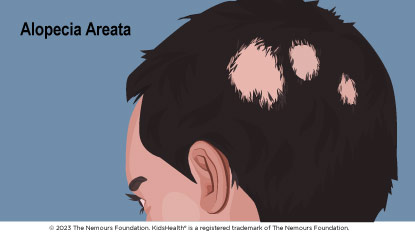Alopecia Areata (Hair Loss)
What Is Alopecia Areata?
Alopecia areata (al-uh-PEE-shuh air-ee-AH-tuh) is a condition that causes hair loss on the scalp and sometimes elsewhere on the body, such as the eyebrows and eyelashes.
The condition is not contagious and usually happens in people who are otherwise healthy.
What Are the Signs & Symptoms of Alopecia Areata?
Alopecia areata often starts suddenly with one or more round, smooth bald patches on the scalp. It is possible for all the hair on the head to fall out, but this isn’t common. Often, hair grows back within several months, even without treatment. It may grow in fine or white at first, but usually returns to its original texture and color with time.
People with alopecia areata may lose and grow back their hair more than once, either in the same patches as before or in different patches. Almost always the hair grows back. Very rarely, the hair loss is permanent.
Alopecia areata also can affect the fingernails and toenails. If it does:
- White spots may appear on the nails.
- The nails may feel pitted, grooved, or rough.
- Nails may be thin and split easily.
What Causes Alopecia Areata?
Alopecia can begin at any age and affect any ethnic group. Boys and girls both can get it. It’s an autoimmune disorder. This means it happens because the body's immune system attacks the hair follicles (the area of skin hair grows from) as if they were a threat. This causes inflammation that disrupts hair growth.
How Is Alopecia Areata Diagnosed?
To diagnose alopecia, doctors will:
- Ask about the person’s medical history and family history (sometimes, other people in the family also have alopecia).
- Examine the areas with hair loss and look at the nails.
- Use a magnifying device to look closely at the hair and hair follicles.
How Is Alopecia Areata Treated?
If your child has alopecia, the doctor might refer you to a dermatologist (a doctor who treats skin, hair, and nail problems).
Alopecia areata doesn’t usually need treatment. But medicine (most often topical steroids) applied to the scalp may help hair grow back faster. Sometimes, for older kids and teens, doctors recommend steroid injections and oral medicines. These treatments don’t cure alopecia areata, though, and hair loss can happen again.

How Can Parents Help?
If your child has alopecia:
- Apply any prescribed skin creams or lotions as directed by the doctor.
- Apply sunscreen to any exposed areas of the scalp and skin before your child goes outdoors.
The hair loss that comes with alopecia areata can be upsetting. These tips might help:
- Many cosmetic options can help kids deal with hair loss. Some like to cover the affected areas with a wig, hair wrap, or hat. Other kids may prefer to shave their heads.
- Older kids and teens who’ve lost their eyelashes might want to try false eyelashes. Stick-on options are easiest.
- Therapy or alopecia areata support groups can help your child deal with negative feelings about hair loss. You can look online at:
When Should I Call the Doctor?
Your child:
- seems depressed
- gets a rash or skin irritation from the treatment
- has signs of a skin infection, such as redness, swelling, warmth, tenderness, fever, or discharge
What Else Should I Know?
Kids and teens with alopecia can also develop other autoimmune disorders, such as thyroid disease or eczema (atopic dermatitis). Be sure your child goes to all medical visits and gets regular checkups so the doctor can watch for any new problems.
Reviewed by: Patrice Hyde, MD
Date Reviewed: Aug 15, 2022
















